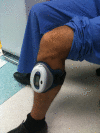Pulsed electromagnetic fields for the treatment of tibial delayed unions and nonunions. A prospective clinical study and review of the literature
- PMID: 22681718
- PMCID: PMC3441225
- DOI: 10.1186/1749-799X-7-24
Pulsed electromagnetic fields for the treatment of tibial delayed unions and nonunions. A prospective clinical study and review of the literature
Abstract
Background: Pulsed electromagnetic fields (PEMF) stimulation for the treatment of bone nonunion or delayed union have been in use for several years, but on a limited basis. The aim of this study was to assess the overall efficacy of the method in tibial delayed unions and nonunions and identify factors that could affect the final outcome.
Methods: We prospectively reviewed 44 patients (27 men) with a mean age of 49.6 ± 18.4 years that received PEMF therapy due to tibial shaft delayed union or nonunion. In all cases, fracture gap was less than 1 cm and infection or soft tissue defects were absent.
Results: Fracture union was confirmed in 34 cases (77.3%). No relationship was found between union rate and age (p = 0.819), fracture side (left or right) (p = 0.734), fracture type (simple or comminuted, open or closed) (p = 0.111), smoking (p = 0.245), diabetes (p = 0.68) and initial treatment method applied (plates, nail, plaster of paris) (p = 0.395). The time of treatment onset didn't affect the incidence of fracture healing (p = 0.841). Although statistical significance was not demonstrated, longer treatment duration showed a trend of increased probability of union (p = 0.081).
Conclusion: PEMF stimulation is an effective non-invasive method for addressing non-infected tibial union abnormalities. Its success is not associated with specific fracture or patient related variables and it couldn't be clearly considered a time-dependent phenomenon.
Figures




Similar articles
-
Pulsed electromagnetic field stimulation for acute tibial shaft fractures: a multicenter, double-blind, randomized trial.J Bone Joint Surg Am. 2011 Sep 7;93(17):1569-76. doi: 10.2106/JBJS.J.00869. J Bone Joint Surg Am. 2011. PMID: 21915570 Clinical Trial.
-
Percutaneous autologous bone marrow injection in the treatment of distal meta-diaphyseal tibial nonunions and delayed unions.J Orthop Trauma. 2013 Sep;27(9):527-33. doi: 10.1097/BOT.0b013e31828bf077. J Orthop Trauma. 2013. PMID: 23443050
-
Early application of pulsed electromagnetic field in the treatment of postoperative delayed union of long-bone fractures: a prospective randomized controlled study.BMC Musculoskelet Disord. 2013 Jan 19;14:35. doi: 10.1186/1471-2474-14-35. BMC Musculoskelet Disord. 2013. PMID: 23331333 Free PMC article. Clinical Trial.
-
Treatment of ununited tibial fractures: a comparison of surgery and pulsed electromagnetic fields (PEMF).Orthopedics. 1992 Jun;15(6):711-9. doi: 10.3928/0147-7447-19920601-08. Orthopedics. 1992. PMID: 1608864 Review.
-
Treatment of aseptic tibial shaft non-union without bone defect.Orthop Traumatol Surg Res. 2018 Feb;104(1S):S63-S69. doi: 10.1016/j.otsr.2017.05.028. Epub 2017 Nov 26. Orthop Traumatol Surg Res. 2018. PMID: 29183822 Review.
Cited by
-
Effect of External Mechanical Stimuli on Human Bone: a narrative review.Prog Biomed Eng (Bristol). 2022 Jan;4(1):012006. doi: 10.1088/2516-1091/ac41bc. Epub 2022 Jan 10. Prog Biomed Eng (Bristol). 2022. PMID: 36310606 Free PMC article.
-
Early protection against bone stress injuries by mobilization of endogenous targeted bone remodeling.iScience. 2023 Aug 11;26(9):107605. doi: 10.1016/j.isci.2023.107605. eCollection 2023 Sep 15. iScience. 2023. PMID: 37664634 Free PMC article.
-
Beneficial Effects of Pulsed Electromagnetic Field during Cast Immobilization in Patients with Distal Radius Fracture.Biomed Res Int. 2020 Feb 25;2020:6849352. doi: 10.1155/2020/6849352. eCollection 2020. Biomed Res Int. 2020. PMID: 32185214 Free PMC article.
-
Synergistic effect of a LPEMF and SPIONs on BMMSC proliferation, directional migration, and osteoblastogenesis.Am J Transl Res. 2018 May 15;10(5):1431-1443. eCollection 2018. Am J Transl Res. 2018. PMID: 29887957 Free PMC article.
-
In vitro functional response of human tendon cells to different dosages of low-frequency pulsed electromagnetic field.Knee Surg Sports Traumatol Arthrosc. 2015 Nov;23(11):3443-53. doi: 10.1007/s00167-014-3143-x. Epub 2014 Jun 24. Knee Surg Sports Traumatol Arthrosc. 2015. PMID: 24957914
References
-
- Kanakaris NK, Paliobeis C, Nlanidakis N, Giannoudis PV. Biological enhancement of tibial diaphyseal aseptic non-unions: the efficacy of autologous bone grafting, BMPs and reaming by-products. Injury. 2007;38(Suppl 2):S65–S75. - PubMed
-
- Gustilo RB, Anderson JT. Prevention of infection in the treatment of one thousand and twenty-five open fractures of long bones: retrospective and prospective analyses. J Bone Joint Surg Am. 1976;58:453–458. - PubMed
-
- The classic. Fundamental aspects of fracture treatment by Iwao Yasuda, reprinted from. J. 1953;4:395–406. Clinical orthopaedics and related research 1977, 124:5–8. - PubMed
Publication types
MeSH terms
LinkOut - more resources
Full Text Sources
Other Literature Sources
Medical
Miscellaneous

